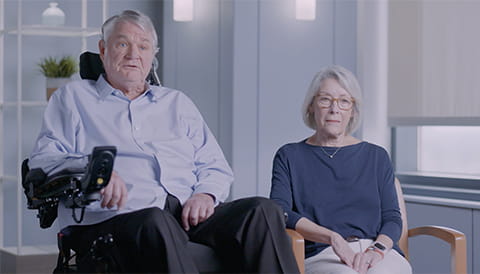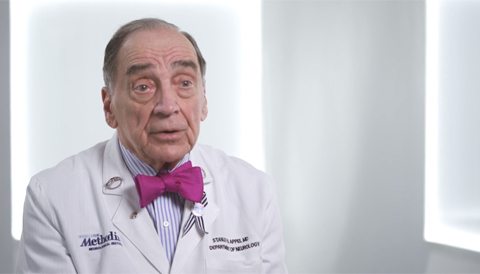Appel LAB
Peggy & Gary Edwards ALS Laboratory

Stanley H. Appel, MD
Peggy and Gary Edwards Distinguished Chair in ALS Research
Director, Ann Kimball and John W. Johnson
Center for Cellular Therapeutics
Co-Director, Houston Methodist
Neurological Institute
Professor of Neurology
Weill Cornell Medical College
Peggy and Gary Edwards Distinguished Chair in ALS Research
Director, Ann Kimball and John W. Johnson
Center for Cellular Therapeutics
Co-Director, Houston Methodist
Neurological Institute
Professor of Neurology
Weill Cornell Medical College
IMMUNE CELLS HOLD PROMISE IN SLOWING DOWN ALS
Patients with neurodegenerative diseases are in desperate need of transformative therapeutic options; harnessing the neuro-protective effects of Treg cell therapy shows great promise in unlocking a new treatment paradigm and will enable us to revolutionize care for patients with devastating neurodegenerative diseases.
Research in Dr. Appel’s laboratory focuses on developing new insights into neurodegenerative diseases, with a primary emphasis on amyotrophic lateral sclerosis (ALS). The major goal is to develop therapeutics that suppress neuroinflammation and the immune/inflammatory alterations that drive neurodegenerative disease progression. In the mSOD1 mouse model of ALS, activated microglia, and T-cell lymphocytes drive disease progression. In vitro studies documented that motor neuron cytotoxicity is produced by pro-inflammatory M1 microglia, and neuroprotection is mediated by anti-inflammatory M2 microglia. The motor neuron injury that initiates the process can be reproduced in vitro with misfolded proteins (mSOD, TDP-43, and FUS) which activate microglia and promote an M1 phenotype that kills motor neurons. Neuroprotective cytokines IL-4 and IL10 released from M2 microglia/macrophages enhance motor neuron survival. In vitro Tregs not only suppress proliferation of Th1, but also suppress pro-inflammatory M1 microglia. These studies suggest that during early stages of disease, motor neurons are capable of intracellular repair abetted by surrounding glia enhanced and modulated by Tregs. However, with increasing injury within the motor neuron, misfolded proteins or their surrogates are released as danger signals and promote the pro-inflammatory M1 phenotype, diminishing protective Tregs and enhancing pro-inflammatory Th1 and Th17.
Definitive evidence for the contribution of activated microglia to disease pathogenesis in the mouse model was produced by crossing the mSOD1 mouse with a PU.1 knockout mouse. Transplants with wild-type (a source of M2 anti-inflammatory microglia) bone marrow significantly prolonged life and disease duration compared to transplants with mSOD1 bone marrow ( a source of M1 pro-inflammatory microglia) thereby confirming the contribution of microglia to motor neuron viability and disease duration. Studies with transgenic mice also established the importance of T lymphocytes in mediating disease duration and motor neuron viability; mSOD mice crossed with Rag2 KO or CD4 KO mice died significantly earlier than mSOD1 mice indicating that a T cell removed in Rag2KO or CD14 KO mice had been neuroprotective. The specific subpopulation of T cells that had been “lost” were regulatory T lymphocytes (Tregs), which was confirmed by transplanting Tregs, which rescued motor neurons and prolonged ALS mouse survival.
Regulatory T lymphocytes also modulate disease progression in ALS patients. Tregs numbers as well as suppressive functions are significantly decreased in ALS patients. This failure of Tregs to suppress T effector lymphocyte proliferation and pro-inflammatory myeloid cytokine secretion promotes neuroinflammation leading to enhanced burden and progression of disease. Isolation of Tregs from ALS patients and expansion ex vivo restores their neuroprotective anti-inflammatory function. Autologous infusions of these expanded Tregs formed the basis of a Phase 1 FDA-approved first-in-man clinical trial in ALS, which was safe and significantly slowed disease progression. A subsequent Phase 2A trial has just been completed, but enrollment and outcomes were compromised by COVID19. Nevertheless, in an open-label 6-month extension in 8 patients, safety and promising beneficial effects were noted. A large clinical study is planned for later his year utilizing this novel cell therapy to offer hope for ALS patients, addressing their unmet needs and enhancing their quality of life.
This game changing Treg platform has now been extended from ex vivo- expanded Tregs and autologous infusions, to include immunosuppressive exosomes derived from the GMP expansion process as well as biologics to enhance Treg expansion in vivo and suppress inflammation in Alzheimer Disease as well as ALS, with future application to other neurodegenerative diseases.
Definitive evidence for the contribution of activated microglia to disease pathogenesis in the mouse model was produced by crossing the mSOD1 mouse with a PU.1 knockout mouse. Transplants with wild-type (a source of M2 anti-inflammatory microglia) bone marrow significantly prolonged life and disease duration compared to transplants with mSOD1 bone marrow ( a source of M1 pro-inflammatory microglia) thereby confirming the contribution of microglia to motor neuron viability and disease duration. Studies with transgenic mice also established the importance of T lymphocytes in mediating disease duration and motor neuron viability; mSOD mice crossed with Rag2 KO or CD4 KO mice died significantly earlier than mSOD1 mice indicating that a T cell removed in Rag2KO or CD14 KO mice had been neuroprotective. The specific subpopulation of T cells that had been “lost” were regulatory T lymphocytes (Tregs), which was confirmed by transplanting Tregs, which rescued motor neurons and prolonged ALS mouse survival.
Regulatory T lymphocytes also modulate disease progression in ALS patients. Tregs numbers as well as suppressive functions are significantly decreased in ALS patients. This failure of Tregs to suppress T effector lymphocyte proliferation and pro-inflammatory myeloid cytokine secretion promotes neuroinflammation leading to enhanced burden and progression of disease. Isolation of Tregs from ALS patients and expansion ex vivo restores their neuroprotective anti-inflammatory function. Autologous infusions of these expanded Tregs formed the basis of a Phase 1 FDA-approved first-in-man clinical trial in ALS, which was safe and significantly slowed disease progression. A subsequent Phase 2A trial has just been completed, but enrollment and outcomes were compromised by COVID19. Nevertheless, in an open-label 6-month extension in 8 patients, safety and promising beneficial effects were noted. A large clinical study is planned for later his year utilizing this novel cell therapy to offer hope for ALS patients, addressing their unmet needs and enhancing their quality of life.
This game changing Treg platform has now been extended from ex vivo- expanded Tregs and autologous infusions, to include immunosuppressive exosomes derived from the GMP expansion process as well as biologics to enhance Treg expansion in vivo and suppress inflammation in Alzheimer Disease as well as ALS, with future application to other neurodegenerative diseases.


